Microsoft AZ-400 Exam Practice Questions (P. 4)
- Full Access (565 questions)
- One Year of Premium Access
- Access to one million comments
- Seamless ChatGPT Integration
- Ability to download PDF files
- Anki Flashcard files for revision
- No Captcha & No AdSense
- Advanced Exam Configuration
Question #31
You are in the process of building a mobile app aimed at Android and iOS devices.
All work items and release cycles are managed via Azure DevOps.
You want to make sure that crash reports for issue analysis is collected, and that beta releases are distributed to your testers. Also, you want to ensure that user feedback on the functionality of new apps is received.
Which of the following must be part of your solution?
All work items and release cycles are managed via Azure DevOps.
You want to make sure that crash reports for issue analysis is collected, and that beta releases are distributed to your testers. Also, you want to ensure that user feedback on the functionality of new apps is received.
Which of the following must be part of your solution?
- AThe Microsoft Test & Feedback extension.Most Voted
- BOWASP ZAP
- CTFS Integration Platform
- DCode Style
Correct Answer:
A
The "Exploratory Testing" extension is now "Test & Feedback" and is now Generally Available.
Anyone can now test web apps and give feedback, all directly from the browser on any platform: Windows, Mac, or Linux. Available for Google Chrome and
Mozilla Firefox (required version 50.0 or above) currently. Support for Microsoft Edge is in the pipeline and will be enabled once Edge moves to a Chromium- compatible web platform.
Reference:
https://marketplace.visualstudio.com/items?itemName=ms.vss-exploratorytesting-web
A
The "Exploratory Testing" extension is now "Test & Feedback" and is now Generally Available.
Anyone can now test web apps and give feedback, all directly from the browser on any platform: Windows, Mac, or Linux. Available for Google Chrome and
Mozilla Firefox (required version 50.0 or above) currently. Support for Microsoft Edge is in the pipeline and will be enabled once Edge moves to a Chromium- compatible web platform.
Reference:
https://marketplace.visualstudio.com/items?itemName=ms.vss-exploratorytesting-web
send
light_mode
delete
Question #32
DRAG DROP -
You need to recommend project metrics for dashboards in Azure DevOps.
Which chart widgets should you recommend for each metric? To answer, drag the appropriate chart widgets to the correct metrics. Each chart widget may be used once, more than once, or not at all. You may need to drag the split bar between panes or scroll to view content.
NOTE: Each correct selection is worth one point.
Select and Place:
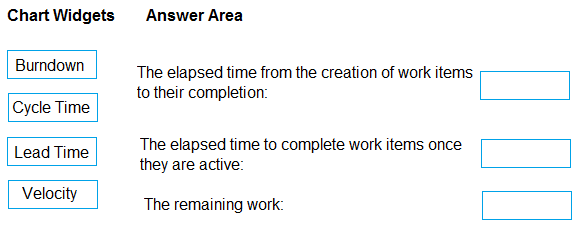
You need to recommend project metrics for dashboards in Azure DevOps.
Which chart widgets should you recommend for each metric? To answer, drag the appropriate chart widgets to the correct metrics. Each chart widget may be used once, more than once, or not at all. You may need to drag the split bar between panes or scroll to view content.
NOTE: Each correct selection is worth one point.
Select and Place:

Correct Answer:
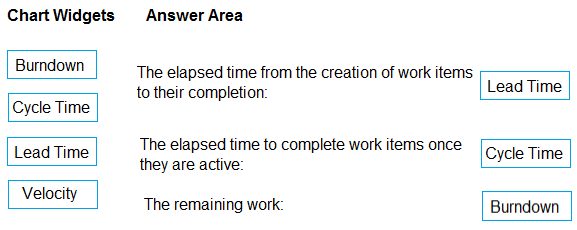
Box 1: Lead time -
Lead time measures the total time elapsed from the creation of work items to their completion.
Box 2: Cycle time -
Cycle time measures the time it takes for your team to complete work items once they begin actively working on them.
Box 3: Burndown -
Burndown charts focus on remaining work within a specific time period.
Incorrect Answers:
Velocity provides a useful metric for these activities:
Support sprint planning -
Forecast future sprints and the backlog items that can be completed
A guide for determining how well the team estimates and meets their planned commitments
Reference:
https://docs.microsoft.com/en-us/azure/devops/report/dashboards/velocity-guidance?view=vsts https://docs.microsoft.com/en-us/azure/devops/report/dashboards/cycle-time-and-lead-time?view=vsts https://docs.microsoft.com/en-us/azure/devops/report/dashboards/configure-burndown-burnup-widgets?view=vsts

Box 1: Lead time -
Lead time measures the total time elapsed from the creation of work items to their completion.
Box 2: Cycle time -
Cycle time measures the time it takes for your team to complete work items once they begin actively working on them.
Box 3: Burndown -
Burndown charts focus on remaining work within a specific time period.
Incorrect Answers:
Velocity provides a useful metric for these activities:
Support sprint planning -
Forecast future sprints and the backlog items that can be completed
A guide for determining how well the team estimates and meets their planned commitments
Reference:
https://docs.microsoft.com/en-us/azure/devops/report/dashboards/velocity-guidance?view=vsts https://docs.microsoft.com/en-us/azure/devops/report/dashboards/cycle-time-and-lead-time?view=vsts https://docs.microsoft.com/en-us/azure/devops/report/dashboards/configure-burndown-burnup-widgets?view=vsts
send
light_mode
delete
Question #33
HOTSPOT -
You plan to create alerts that will be triggered based on the page load performance of a home page.
You have the Application Insights log query shown in the following exhibit.
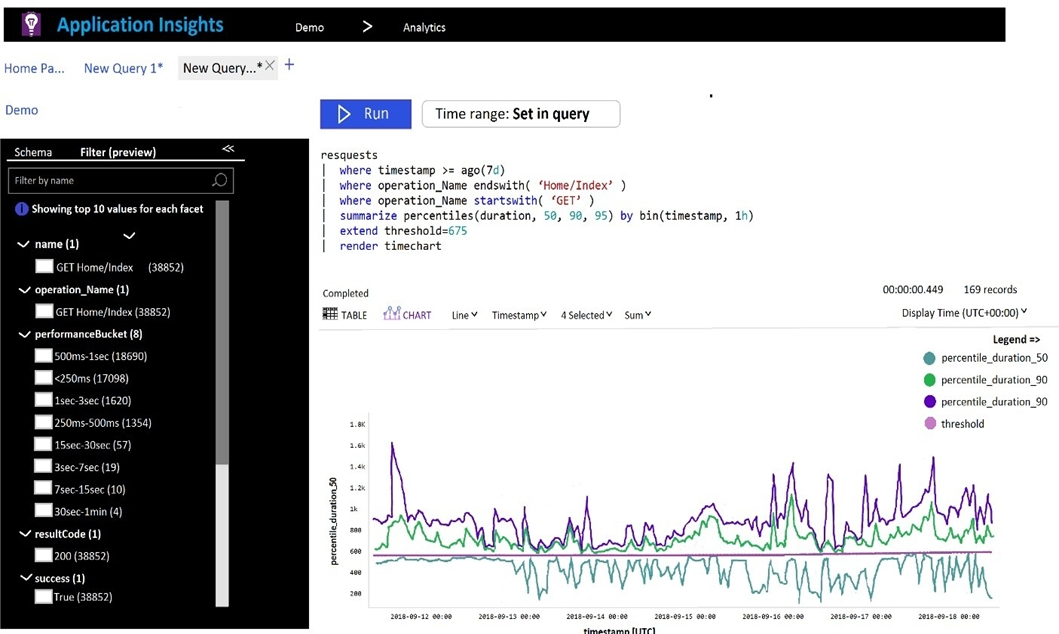
Use the drop-down menus to select the answer choice that completes each statement based on the information presented in the graphic.
NOTE: Each correct selection is worth one point.
Hot Area:
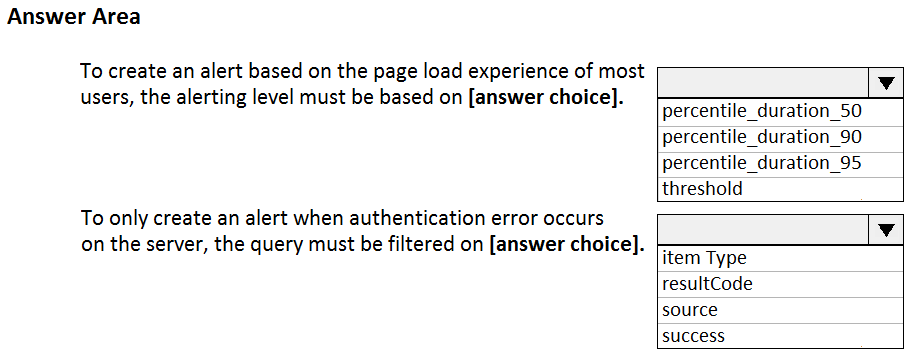
You plan to create alerts that will be triggered based on the page load performance of a home page.
You have the Application Insights log query shown in the following exhibit.

Use the drop-down menus to select the answer choice that completes each statement based on the information presented in the graphic.
NOTE: Each correct selection is worth one point.
Hot Area:

Correct Answer:

Box 1: percentile_duration_95 -
Box 2: success -
For example ג€"
requests
| project name, url, success
| where success == "False"
This will return all the failed requests in my App Insights within the specified time range.
Reference:
https://devblogs.microsoft.com/premier-developer/alerts-based-on-analytics-query-using-custom-log-search/

Box 1: percentile_duration_95 -
Box 2: success -
For example ג€"
requests
| project name, url, success
| where success == "False"
This will return all the failed requests in my App Insights within the specified time range.
Reference:
https://devblogs.microsoft.com/premier-developer/alerts-based-on-analytics-query-using-custom-log-search/
send
light_mode
delete
Question #34
You manage an Azure web app that supports an e-commerce website.
You need to increase the logging level when the web app exceeds normal usage patterns. The solution must minimize administrative overhead.
Which two resources should you include in the solution? Each correct answer presents part of the solution.
NOTE: Each correct selection is worth one point.
You need to increase the logging level when the web app exceeds normal usage patterns. The solution must minimize administrative overhead.
Which two resources should you include in the solution? Each correct answer presents part of the solution.
NOTE: Each correct selection is worth one point.
- Aan Azure Automation runbookMost Voted
- Ban Azure Monitor alert that has a dynamic thresholdMost Voted
- Can Azure Monitor alert that has a static threshold
- Dthe Azure Monitor autoscale settings
- Ean Azure Monitor alert that uses an action group that has an email action
Correct Answer:
AB
B: Metric Alert with Dynamic Thresholds detection leverages advanced machine learning (ML) to learn metrics' historical behavior, identify patterns and anomalies that indicate possible service issues. It provides support of both a simple UI and operations at scale by allowing users to configure alert rules through the Azure
Resource Manager API, in a fully automated manner.
A: You can use Azure Monitor to monitor base-level metrics and logs for most services in Azure. You can call Azure Automation runbooks by using action groups or by using classic alerts to automate tasks based on alerts.
Reference:
https://docs.microsoft.com/en-us/azure/azure-monitor/platform/alerts-dynamic-thresholds https://docs.microsoft.com/en-us/azure/automation/automation-create-alert-triggered-runbook
AB
B: Metric Alert with Dynamic Thresholds detection leverages advanced machine learning (ML) to learn metrics' historical behavior, identify patterns and anomalies that indicate possible service issues. It provides support of both a simple UI and operations at scale by allowing users to configure alert rules through the Azure
Resource Manager API, in a fully automated manner.
A: You can use Azure Monitor to monitor base-level metrics and logs for most services in Azure. You can call Azure Automation runbooks by using action groups or by using classic alerts to automate tasks based on alerts.
Reference:
https://docs.microsoft.com/en-us/azure/azure-monitor/platform/alerts-dynamic-thresholds https://docs.microsoft.com/en-us/azure/automation/automation-create-alert-triggered-runbook
send
light_mode
delete
Question #35
HOTSPOT -
You have an Azure Kubernetes Service (AKS) pod.
You need to configure a probe to perform the following actions:
✑ Confirm that the pod is responding to service requests.
✑ Check the status of the pod four times a minute.
✑ Initiate a shutdown if the pod is unresponsive.
How should you complete the YAML configuration file? To answer, select the appropriate options in the answer area.
NOTE: Each correct selection is worth one point.
Hot Area:
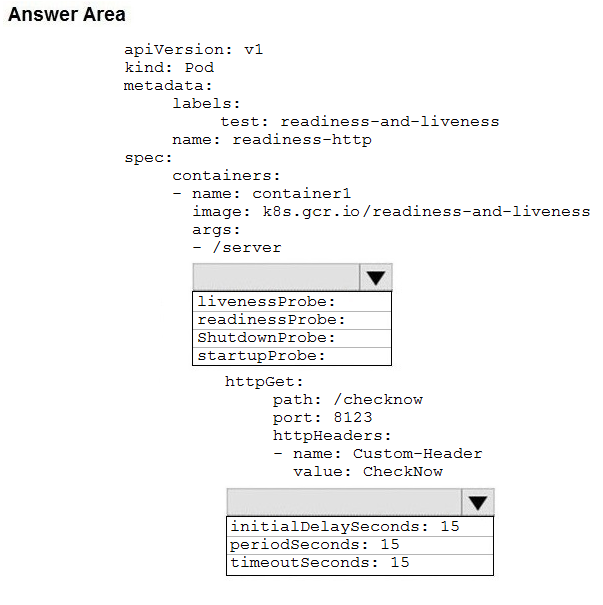
You have an Azure Kubernetes Service (AKS) pod.
You need to configure a probe to perform the following actions:
✑ Confirm that the pod is responding to service requests.
✑ Check the status of the pod four times a minute.
✑ Initiate a shutdown if the pod is unresponsive.
How should you complete the YAML configuration file? To answer, select the appropriate options in the answer area.
NOTE: Each correct selection is worth one point.
Hot Area:

Correct Answer:
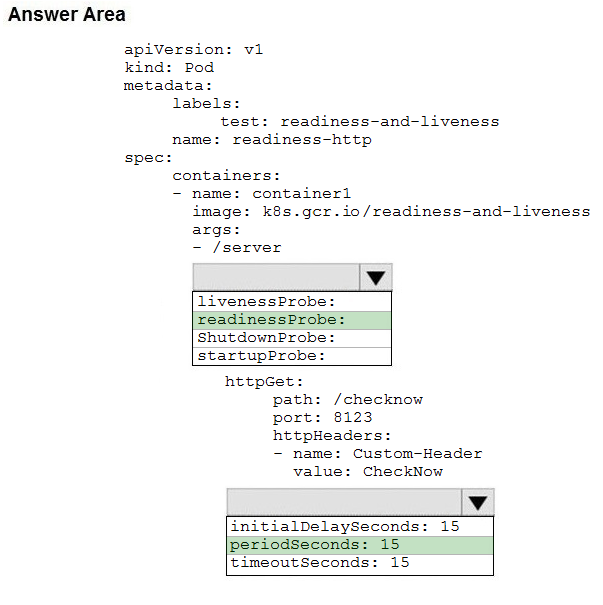
Box 1: readinessProbe:
For containerized applications that serve traffic, you might want to verify that your container is ready to handle incoming requests. Azure Container Instances supports readiness probes to include configurations so that your container can't be accessed under certain conditions.
Incorrect Answers:
livenessProbe: Containerized applications may run for extended periods of time, resulting in broken states that may need to be repaired by restarting the container. Azure Container Instances supports liveness probes so that you can configure your containers within your container group to restart if critical functionality is not working.
Box 2: periodSeconds: 15 -
The periodSeconds property designates the readiness command should execute every 15 seconds.
Reference:
https://docs.microsoft.com/en-us/azure/container-instances/container-instances-readiness-probe

Box 1: readinessProbe:
For containerized applications that serve traffic, you might want to verify that your container is ready to handle incoming requests. Azure Container Instances supports readiness probes to include configurations so that your container can't be accessed under certain conditions.
Incorrect Answers:
livenessProbe: Containerized applications may run for extended periods of time, resulting in broken states that may need to be repaired by restarting the container. Azure Container Instances supports liveness probes so that you can configure your containers within your container group to restart if critical functionality is not working.
Box 2: periodSeconds: 15 -
The periodSeconds property designates the readiness command should execute every 15 seconds.
Reference:
https://docs.microsoft.com/en-us/azure/container-instances/container-instances-readiness-probe
send
light_mode
delete
Question #36
You have a Microsoft ASP.NET Core web app in Azure that is accessed worldwide.
You need to run a URL ping test once every five minutes and create an alert when the web app is unavailable from specific Azure regions. The solution must minimize development time.
What should you do?
You need to run a URL ping test once every five minutes and create an alert when the web app is unavailable from specific Azure regions. The solution must minimize development time.
What should you do?
- ACreate an Azure Monitor Availability metric and alert.
- BCreate an Azure Application Insights availability test and alert.Most Voted
- CWrite an Azure function and deploy the function to the specific regions.
- DCreate an Azure Service Health alert for the specific regions.
Correct Answer:
B
There are three types of Application Insights availability tests:
URL ping test: a simple test that you can create in the Azure portal.

✑ Multi-step web test
✑ Custom Track Availability Tests
Note: After you've deployed your web app/website, you can set up recurring tests to monitor availability and responsiveness. Azure Application Insights sends web requests to your application at regular intervals from points around the world. It can alert you if your application isn't responding, or if it responds too slowly.
You can set up availability tests for any HTTP or HTTPS endpoint that is accessible from the public internet. You don't have to make any changes to the website you're testing. In fact, it doesn't even have to be a site you own. You can test the availability of a REST API that your service depends on.
Reference:
https://docs.microsoft.com/en-us/azure/azure-monitor/app/monitor-web-app-availability#create-a-url-ping-test
B
There are three types of Application Insights availability tests:
URL ping test: a simple test that you can create in the Azure portal.

✑ Multi-step web test
✑ Custom Track Availability Tests
Note: After you've deployed your web app/website, you can set up recurring tests to monitor availability and responsiveness. Azure Application Insights sends web requests to your application at regular intervals from points around the world. It can alert you if your application isn't responding, or if it responds too slowly.
You can set up availability tests for any HTTP or HTTPS endpoint that is accessible from the public internet. You don't have to make any changes to the website you're testing. In fact, it doesn't even have to be a site you own. You can test the availability of a REST API that your service depends on.
Reference:
https://docs.microsoft.com/en-us/azure/azure-monitor/app/monitor-web-app-availability#create-a-url-ping-test
send
light_mode
delete
Question #37
You have a multi-tier application. The front end of the application is hosted in Azure App Service.
You need to identify the average load times of the application pages.
What should you use?
You need to identify the average load times of the application pages.
What should you use?
- AAzure Application InsightsMost Voted
- Bthe activity log of the App Service
- Cthe diagnostics logs of the App Service
- DAzure Advisor
Correct Answer:
A
Application Insights will tell you about any performance issues and exceptions, and help you find and diagnose the root causes.
Application Insights can monitor both Java and ASP.NET web applications and services, WCF services. They can be hosted on-premises, on virtual machines, or as Microsoft Azure websites.
On the client side, Application Insights can take telemetry from web pages and a wide variety of devices including iOS, Android, and Windows Store apps.
Reference:
https://docs.microsoft.com/en-us/azure/azure-monitor/app/web-monitor-performance
A
Application Insights will tell you about any performance issues and exceptions, and help you find and diagnose the root causes.
Application Insights can monitor both Java and ASP.NET web applications and services, WCF services. They can be hosted on-premises, on virtual machines, or as Microsoft Azure websites.
On the client side, Application Insights can take telemetry from web pages and a wide variety of devices including iOS, Android, and Windows Store apps.
Reference:
https://docs.microsoft.com/en-us/azure/azure-monitor/app/web-monitor-performance
send
light_mode
delete
Question #38
SIMULATION -
You need to create an instance of Azure Application Insights named az400-123456789-main and configure the instance to receive telemetry data from an Azure web app named az400-123456789-main.
To complete this task, sign in to the Microsoft Azure portal.
You need to create an instance of Azure Application Insights named az400-123456789-main and configure the instance to receive telemetry data from an Azure web app named az400-123456789-main.
To complete this task, sign in to the Microsoft Azure portal.
Correct Answer:
See explanation below.
Step 1: Create an instance of Azure Application Insights
1. Open Microsoft Azure Portal
2. Log into your Azure account, Select Create a resource > Developer tools > Application Insights.

3. Enter the following settings, and then select Review + create.
Name: az400-123456789-main -
Step 2: Configure App Insights SDK
1. Open your ASP.NET Core Web App project in Visual Studio > Right-click on the AppName in the Solution Explorer > Select Add > Application Insights
Telemetry.
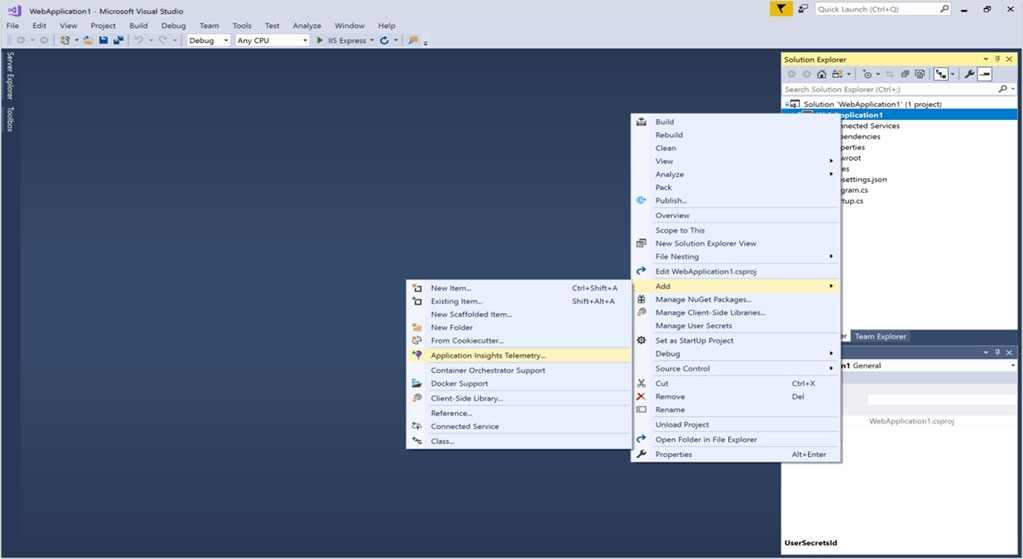
2. Click the Get Started button
3. Select your account and subscription > Select the Existing resource you created in the Azure portal > Click Register.
Reference:
https://docs.microsoft.com/bs-latn-ba/azure/azure-monitor/learn/dotnetcore-quick-start?view=vs-2017
See explanation below.
Step 1: Create an instance of Azure Application Insights
1. Open Microsoft Azure Portal
2. Log into your Azure account, Select Create a resource > Developer tools > Application Insights.

3. Enter the following settings, and then select Review + create.
Name: az400-123456789-main -
Step 2: Configure App Insights SDK
1. Open your ASP.NET Core Web App project in Visual Studio > Right-click on the AppName in the Solution Explorer > Select Add > Application Insights
Telemetry.

2. Click the Get Started button
3. Select your account and subscription > Select the Existing resource you created in the Azure portal > Click Register.
Reference:
https://docs.microsoft.com/bs-latn-ba/azure/azure-monitor/learn/dotnetcore-quick-start?view=vs-2017
send
light_mode
delete
Question #39
Your company uses ServiceNow for incident management.
You develop an application that runs on Azure.
The company needs to generate a ticket in ServiceNow when the application fails to authenticate.
Which Azure Log Analytics solution should you use?
You develop an application that runs on Azure.
The company needs to generate a ticket in ServiceNow when the application fails to authenticate.
Which Azure Log Analytics solution should you use?
- AApplication Insights Connector
- BAutomation & Control
- CIT Service Management Connector (ITSM)Most Voted
- DInsight & Analytics
Correct Answer:
C
The IT Service Management Connector (ITSMC) allows you to connect Azure and a supported IT Service Management (ITSM) product/service.
ITSMC supports connections with the following ITSM tools:
✑ ServiceNow
✑ System Center Service Manager
✑ Provance
✑ Cherwell
With ITSMC, you can -
✑ Create work items in ITSM tool, based on your Azure alerts (metric alerts, Activity Log alerts and Log Analytics alerts).
✑ Optionally, you can sync your incident and change request data from your ITSM tool to an Azure Log Analytics workspace.
Reference:
https://docs.microsoft.com/en-us/azure/azure-monitor/platform/itsmc-overview
C
The IT Service Management Connector (ITSMC) allows you to connect Azure and a supported IT Service Management (ITSM) product/service.
ITSMC supports connections with the following ITSM tools:
✑ ServiceNow
✑ System Center Service Manager
✑ Provance
✑ Cherwell
With ITSMC, you can -
✑ Create work items in ITSM tool, based on your Azure alerts (metric alerts, Activity Log alerts and Log Analytics alerts).
✑ Optionally, you can sync your incident and change request data from your ITSM tool to an Azure Log Analytics workspace.
Reference:
https://docs.microsoft.com/en-us/azure/azure-monitor/platform/itsmc-overview
send
light_mode
delete
Question #40
HOTSPOT -
Your company is building a new web application.
You plan to collect feedback from pilot users on the features being delivered.
All the pilot users have a corporate computer that has Google Chrome and the Microsoft Test & Feedback extension installed. The pilot users will test the application by using Chrome.
You need to identify which access levels are required to ensure that developers can request and gather feedback from the pilot users. The solution must use the principle of least privilege.
Which access levels in Azure DevOps should you identify? To answer, select the appropriate options in the answer area.
NOTE: Each correct selection is worth one point.
Hot Area:
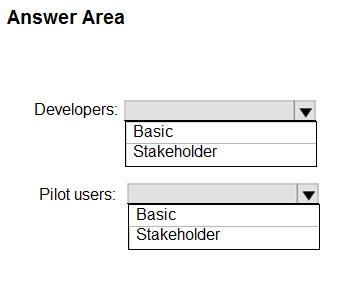
Your company is building a new web application.
You plan to collect feedback from pilot users on the features being delivered.
All the pilot users have a corporate computer that has Google Chrome and the Microsoft Test & Feedback extension installed. The pilot users will test the application by using Chrome.
You need to identify which access levels are required to ensure that developers can request and gather feedback from the pilot users. The solution must use the principle of least privilege.
Which access levels in Azure DevOps should you identify? To answer, select the appropriate options in the answer area.
NOTE: Each correct selection is worth one point.
Hot Area:

Correct Answer:
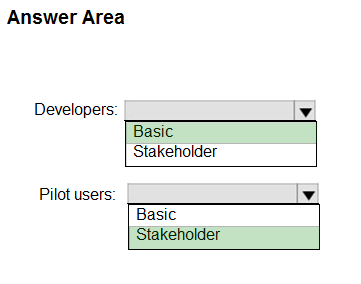
Box 1: Basic -
Assign Basic to users with a TFS CAL, with a Visual Studio Professional subscription, and to users for whom you are paying for Azure Boards & Repos in an organization.
Box 2: Stakeholder -
Assign Stakeholders to users with no license or subscriptions who need access to a limited set of features.
Note:
You assign users or groups of users to one of the following access levels:
Basic: provides access to most features
VS Enterprise: provides access to premium features
Stakeholders: provides partial access, can be assigned to unlimited users for free
Reference:
https://docs.microsoft.com/en-us/azure/devops/organizations/security/access-levels?view=vsts

Box 1: Basic -
Assign Basic to users with a TFS CAL, with a Visual Studio Professional subscription, and to users for whom you are paying for Azure Boards & Repos in an organization.
Box 2: Stakeholder -
Assign Stakeholders to users with no license or subscriptions who need access to a limited set of features.
Note:
You assign users or groups of users to one of the following access levels:
Basic: provides access to most features
VS Enterprise: provides access to premium features
Stakeholders: provides partial access, can be assigned to unlimited users for free
Reference:
https://docs.microsoft.com/en-us/azure/devops/organizations/security/access-levels?view=vsts
send
light_mode
delete
All Pages
